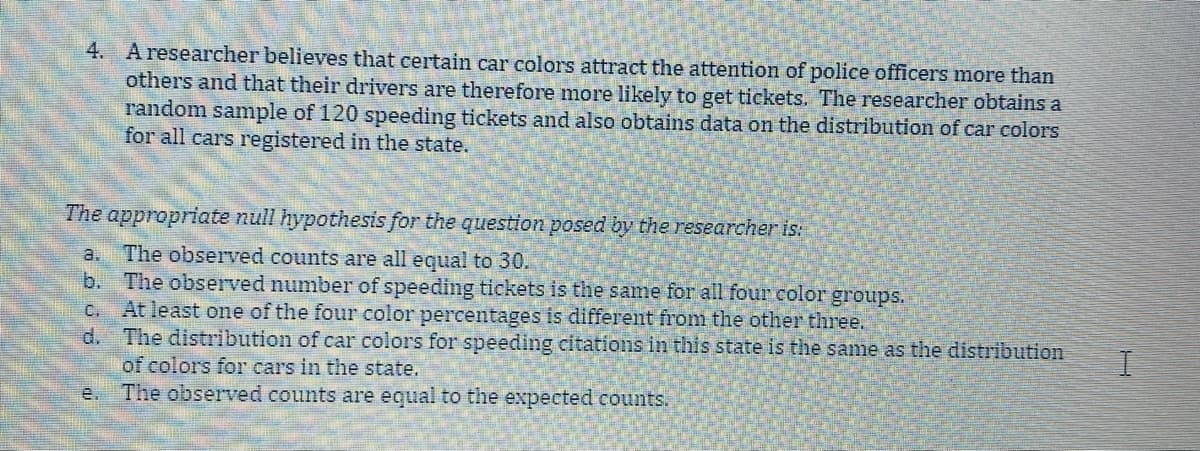The appropriate null hypothesis for the question posed by the researcher is: a. The observed counts are all equal to 30. b. The observed number of speeding tickets is the same for all four color groups. C. At least one of the four color percentages is different from the other three. d. The distribution of car colors for speeding citations in this state is the same as the distribution of colors for cars in the state. e. The observed counts are equal to the expected counts.
The appropriate null hypothesis for the question posed by the researcher is: a. The observed counts are all equal to 30. b. The observed number of speeding tickets is the same for all four color groups. C. At least one of the four color percentages is different from the other three. d. The distribution of car colors for speeding citations in this state is the same as the distribution of colors for cars in the state. e. The observed counts are equal to the expected counts.
Holt Mcdougal Larson Pre-algebra: Student Edition 2012
1st Edition
ISBN:9780547587776
Author:HOLT MCDOUGAL
Publisher:HOLT MCDOUGAL
Chapter11: Data Analysis And Probability
Section: Chapter Questions
Problem 8CR
Related questions
Topic Video
Question

Transcribed Image Text:4. Aresearcher believes that certain car colors attract the attention of police officers more than
others and that their drivers are therefore more likely to get tickets. The researcher obtains a
random sample of 120 speeding tickets and also obtains data on the distribution of car colors
for all cars registered in the state.
The appropriate null hypothesis for the question posed by the researcher is:
The observed counts are all equal to 30.
b. The observed number of speeding tickets is the same for all four color groups.
At least one of the four color percentages is different from the other three.
The distribution of car colors for speeding citations in this state is the same as the distribution
of colors for cars in the state.
The observed counts are equal to the expected counts.
a.
C.
d.
e.
Expert Solution
This question has been solved!
Explore an expertly crafted, step-by-step solution for a thorough understanding of key concepts.
Step by step
Solved in 2 steps with 2 images

Knowledge Booster
Learn more about
Need a deep-dive on the concept behind this application? Look no further. Learn more about this topic, statistics and related others by exploring similar questions and additional content below.Recommended textbooks for you

Holt Mcdougal Larson Pre-algebra: Student Edition…
Algebra
ISBN:
9780547587776
Author:
HOLT MCDOUGAL
Publisher:
HOLT MCDOUGAL

College Algebra (MindTap Course List)
Algebra
ISBN:
9781305652231
Author:
R. David Gustafson, Jeff Hughes
Publisher:
Cengage Learning

Holt Mcdougal Larson Pre-algebra: Student Edition…
Algebra
ISBN:
9780547587776
Author:
HOLT MCDOUGAL
Publisher:
HOLT MCDOUGAL

College Algebra (MindTap Course List)
Algebra
ISBN:
9781305652231
Author:
R. David Gustafson, Jeff Hughes
Publisher:
Cengage Learning